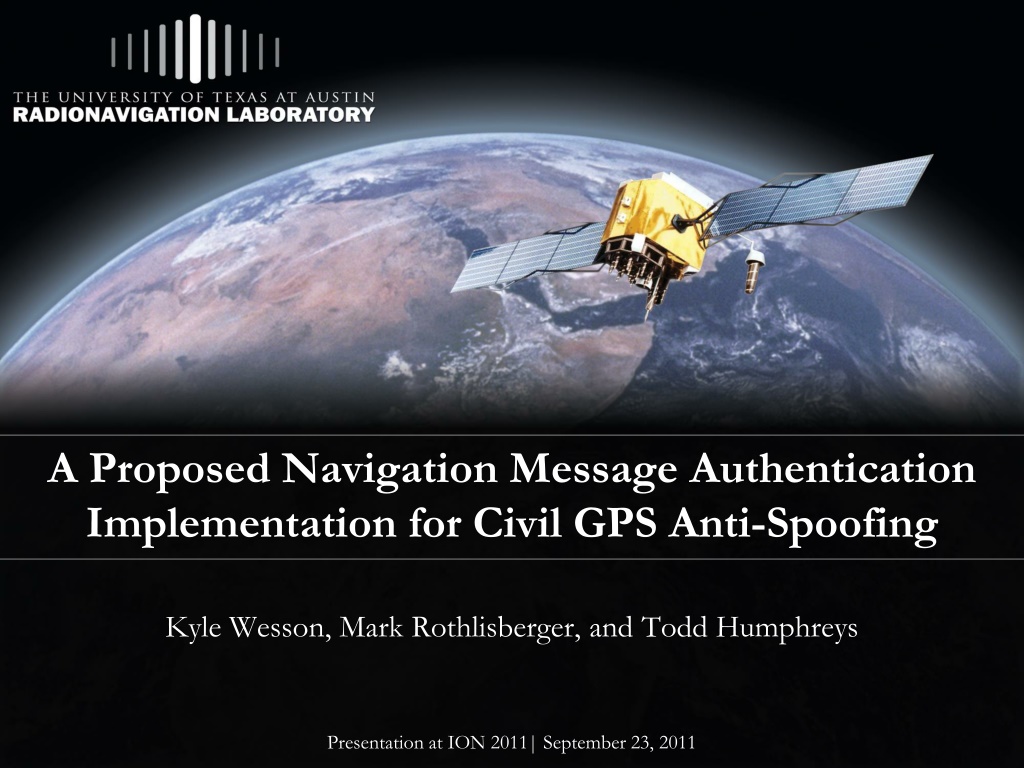
Proposed Navigation Message Authentication for Civil GPS Anti-Spoofing
Explore a proposed navigation message authentication implementation for Civil GPS Anti-Spoofing by Kyle Wesson, Mark Rothlisberger, and Todd Humphreys. The presentation covers security-enhanced GNSS signal authentication, GPS cryptographic signal authentication strategy, and authentication performance. Discover different types of Civil Anti-Spoofing and the importance of navigation message authentication in protecting against spoofing attacks.
Download Presentation

Please find below an Image/Link to download the presentation.
The content on the website is provided AS IS for your information and personal use only. It may not be sold, licensed, or shared on other websites without obtaining consent from the author. Download presentation by click this link. If you encounter any issues during the download, it is possible that the publisher has removed the file from their server.
E N D
Presentation Transcript
A Proposed Navigation Message Authentication Implementation for Civil GPS Anti-Spoofing Kyle Wesson, Mark Rothlisberger, and Todd Humphreys Presentation at ION 2011| September 23, 2011
Our Recent Work http://radionavlab.ae.utexas.edu/publications
Outline Introduction: Civil GPS Anti-Spoofing I. Security-Enhanced GNSS Signal Authentication II. Proposed GPS Cryptographic Signal Authentication Strategy III. Authentication Performance and Experimental Results Conclusions
Types of Civil Anti-Spoofing Civil Anti-Spoofing Non- Cryptographic Cryptographic Navigation Message Authentication Spreading Code Authentication Dual-Receiver Correlation Multi-Antenna Defense Vestigial Signal Defense (VSD) Why navigation message authentication? Offers significant protection against spoofing relative to additional cost and bulk required for implementation Practical and surprisingly effective Suggested by Logan Scott in 2003 Why cryptographic? Does not require additional hardware at receiver Can distinguish authentic from spoofed signal
Part I: Security-Enhanced GNSS Signal Authentication
Security-Enhanced GNSS Signal Model Security code : Generalization of binary modulating sequence Either fully encrypted or contains periodic authentication codes Unpredictable to would be spoofer
Attacking Security-Enhanced GNSS Signals 1. Meaconing: Spoofer records and re-broadcasts entire block of RF spectrum containing ensemble of GNSS signals 2. Security Code Estimation and Replay (SCER) Attack: Spoofer estimates unpredictable security code chips from authentic signals on-the-fly
What does it take to authenticate a GNSS Signal? Code Timing Authentication Code Origin Authentication
Operational Definition: GNSS Signal Authentication GNSS signal is declared authentic if: Logical output S has remained low Logical output H1 has remained low, and 3. Output PD has remained above an acceptable threshold 1. 2.
Part II: Proposed GPS Cryptographic Signal Authentication Strategy
What qualities should cryptographic civil GPS signal authentication have? 1. Effective: they make it difficult for a spoofer to carry off a successful spoofing attack 2. Practical: they are likely to be implemented and adopted by the GPS community
A strategy that meets these requirements: Navigation Message Authentication (NMA): Forms by making the navigation message periodically unpredictable Applies public-key cryptographic digital signature and verification techniques
Public-Key Digital Signatures for GPS Digital signatures allow messages to be signed and then verified: Elliptic Curve Digital Signature Algorithm (ECDSA) is most appropriate for GPS: It s standardized It s efficient to verify signatures It has a short signature length (but not too short!)
Where do we put the digital signature? Civil Navigation (CNAV) Message: Flexible and extensible message format Packet-like structure: Every 12 seconds, broadcast 300-bit packet Message type identification field can identify up to 64 messages of which only 15 are defined
Signing the CNAV Message Delivers ECDSA signature every five minutes per channel Delivers 476 unpredictable navigation message bits Offset scheme could lower time-between-authentications
Part III: Authentication Performance and Experimental Results
Challenging Spoofing Attack Scenario Challenging attack scenario from receiver s perspective: Spoofer has 3 dB carrier-to-noise ratio advantage over the receiver Received spoofed signals are 1.1 times stronger than the received authentic signals Spoofer has introduce a timing error of 1 microsecond in the receiver False alarm probability for SCER detector is 0.0001
Conclusions GNSS signal authentication is probabilistic Navigation message authentication is practical and surprisingly effective for civil GPS anti-spoofing CNAV message can be extended to broadcast digital signatures Visit us on the web: http://radionavlab.ae.utexas.edu
